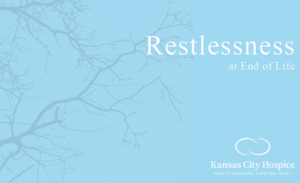 by Pamela Harris, MD, FAAPMR, FAAHPM, Director of Medical Programs at Kansas City Hospice
by Pamela Harris, MD, FAAPMR, FAAHPM, Director of Medical Programs at Kansas City Hospice
“You know, dying is something like being born — sometimes it’s easy and sometimes it’s hard work.”
About Restlessness
As end of life nears, many people experience restlessness. Family and friends may be surprised when a usually calm person becomes restless or agitated. There may be mood swings or personality changes. Restlessness can vary greatly in end of life care.
Many people will experience delirium. This means they may not be thinking clearly and may have less awareness of what is happening.
Despite being very weak, they might insist on changing positions often. They may yell or seem angry.
Some people with delirium are afraid. They may want to go to the emergency room or call the police. A few with delirium believe someone unseen is trying to hurt them. They might not recognize people or seem to be living in the past.
These symptoms can be very upsetting to family and friends. You may feel helpless not knowing what your loved one is trying to say or how to help them. It may feel out of control and can be very difficult for everyone.
Like pain, restlessness and delirium, are best treated early. To provide compassionate care, it helps to know what to look for. If you see changes in mood, behavior or ability to sleep, report it to your hospice nurse. Sometimes symptoms can be improved with medications and simple changes.
Causes of Restlessness
Exact causes may be unclear. Many changes happen when a person nears death. Organs fail. Waste can build up in the system. This may cause confusion and behavioral changes.
Emotional upset or fear may be part of the problem.
Different combinations of drugs can be a factor. Medications may be over- or under-used. It’s helpful to reduce non-comfort medications. Your hospice team will guide you.
If identified, your team will attempt to treat the cause. Some causes of delirium are reversible.
Our job as a team of family, caregivers and hospice professionals is to do everything possible to make the dying person more comfortable.
Possible Treatments
There’s a wide range of treatments available for restlessness. Your nurse will assess the situation to find the most likely cause. But, a specific treatable cause may be hard to find.
Your hospice team may try different approaches to see which treatment might be most effective.
In the meantime, do whatever you feel is most calming and reassuring for the person who is dying and for yourself.
What to Look For
Look for changes, such as:
- Aimless movements, picking at sheets or clothing, looking disturbed, frowning, grunting, being surprised or afraid
- Changes in speech
- Irritability, agitation, mood swings or difficulty focusing
- Changes in alertness, difficulty sleeping or not being aware of surroundings
- Increased confusion (when previously clear), poor memory or short attention span
- Not recognizing people or not knowing where they are
- Appearing to see, hear or feel things that aren’t there, motioning or calling out to people who aren’t there
- Crying out for help, not being able to tell what’s wrong, profanity, undressing, trying to get out of bed or out of the room
What Does this Distress Mean?
Please understand that sometimes, no matter what is done, the dying process is not as peaceful as hoped.
People usually want to make sense of things, but with restlessness or delirium, it can be difficult.
You may look for messages hidden in confused words. You may try to imagine what they’re trying to tell you. But, you can’t always find meaning. What you see and hear is not necessarily a message or symbol, but just the body letting go.
This is a time to step away and talk honestly with your hospice nurse about the situation. They will listen to your concerns.
Your hospice team will be there for you. By starting hospice as early as possible, you can have a relationship that lets the team know you, your loved one and your family.
The important thing is that you’re there, providing reassurance and support as the body lets go of life.
Suggestions
- Sudden changes at end of life may make people feel anxious and upset. Here’s what you can do:
- Stay calm. If you are anxious, it can make things worse.
- Contact the hospice nurse, because early assessment and treatment are important.
- Quietly keep the person safe.
- Gently remind them who you are and what you’re doing. “Mother, it’s Mary. I’m right here and I’m going to straighten the covers.”
- Don’t ask questions, just reassure.
- Do whatever feels calming and appropriate: gently wipe the face with a warm cloth, brush hair, play favorite music, quietly sing or hum familiar songs, or simply hold hands.
- Try to keep to usual routines.
- Provide a quiet, peaceful setting.
- Keep low lights on at night.
“Remember, your very presence and caring, even if you feel unsettled, are profound gifts of love.”
This information is available on request as a patient education brochure in our Kansas City Hospice® Safe Passage Series.

Posted in General, Hospice Care, Stories of Support
